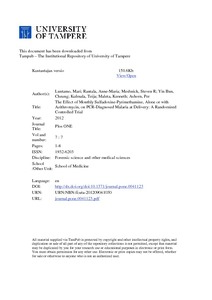The Effect of Monthly Sulfadoxine-Pyrimethamine, Alone or with Azithromycin, on PCR-Diagnosed Malaria at Delivery: A Randomized Controlled Trial
Luntamo, Mari; Rantala, Anne-Maria; Meshnick, Steven R; Yin Bun, Cheung; Kulmala, Teija; Maleta, Kenneth; Ashorn, Per (2012)
Luntamo, Mari
Rantala, Anne-Maria
Meshnick, Steven R
Yin Bun, Cheung
Kulmala, Teija
Maleta, Kenneth
Ashorn, Per
2012
Plos ONE 7 7
1-8
Lääketieteen yksikkö - School of Medicine
This publication is copyrighted. You may download, display and print it for Your own personal use. Commercial use is prohibited.
Julkaisun pysyvä osoite on
https://urn.fi/URN:NBN:fi:uta-201209041030
https://urn.fi/URN:NBN:fi:uta-201209041030
Kuvaus
Public Library of Science open access
Tiivistelmä
Background
New regimens for intermittent preventive treatment in pregnancy (IPTp) against malaria are needed as the effectiveness of the standard two-dose sulfadoxine-pyrimethamine (SP) regimen is under threat. Previous trials have shown that IPTp with monthly SP benefits HIV-positive primi- and secundigravidae, but there is no conclusive evidence of the possible benefits of this regimen to HIV-negative women, or to a population comprising of both HIV-positive and –negative women of different gravidities.
Methods
This study analyzed 484 samples collected at delivery as part of a randomized, partially placebo controlled clinical trial, conducted in rural Malawi between 2003 and 2007. The study included pregnant women regardless of their gravidity or HIV-infection status. The participants received SP twice (controls), monthly SP, or monthly SP and two doses of azithromycin (AZI-SP). The main outcome was the prevalence of peripheral Plasmodium falciparum malaria at delivery diagnosed with a real-time polymerase chain reaction (PCR) assay.
Findings
Overall prevalence of PCR-diagnosed peripheral P. falciparum malaria at delivery was 10.5%. Compared with the controls, participants in the monthly SP group had a risk ratio (95% CI) of 0.33 (0.17 to 0.64, P<0.001) and those in the AZI-SP group 0.23 (0.11 to 0.48, P<0.001) for malaria at delivery. When only HIV-negative participants were analyzed, the corresponding figures were 0.26 (0.12 to 0.57, P<0.001) for women in the monthly SP group, and 0.24 (0.11 to 0.53, P<0.001) for those in the AZI-SP group.
Conclusions
Our results suggest that increasing the frequency of SP administration during pregnancy improves the efficacy against malaria at delivery among HIV-negative women, as well as a population consisting of both HIV-positive and –negative pregnant women of all gravidities, in a setting of relatively low but holoendemic malaria transmission, frequent use of bed nets and high SP resistance.
New regimens for intermittent preventive treatment in pregnancy (IPTp) against malaria are needed as the effectiveness of the standard two-dose sulfadoxine-pyrimethamine (SP) regimen is under threat. Previous trials have shown that IPTp with monthly SP benefits HIV-positive primi- and secundigravidae, but there is no conclusive evidence of the possible benefits of this regimen to HIV-negative women, or to a population comprising of both HIV-positive and –negative women of different gravidities.
Methods
This study analyzed 484 samples collected at delivery as part of a randomized, partially placebo controlled clinical trial, conducted in rural Malawi between 2003 and 2007. The study included pregnant women regardless of their gravidity or HIV-infection status. The participants received SP twice (controls), monthly SP, or monthly SP and two doses of azithromycin (AZI-SP). The main outcome was the prevalence of peripheral Plasmodium falciparum malaria at delivery diagnosed with a real-time polymerase chain reaction (PCR) assay.
Findings
Overall prevalence of PCR-diagnosed peripheral P. falciparum malaria at delivery was 10.5%. Compared with the controls, participants in the monthly SP group had a risk ratio (95% CI) of 0.33 (0.17 to 0.64, P<0.001) and those in the AZI-SP group 0.23 (0.11 to 0.48, P<0.001) for malaria at delivery. When only HIV-negative participants were analyzed, the corresponding figures were 0.26 (0.12 to 0.57, P<0.001) for women in the monthly SP group, and 0.24 (0.11 to 0.53, P<0.001) for those in the AZI-SP group.
Conclusions
Our results suggest that increasing the frequency of SP administration during pregnancy improves the efficacy against malaria at delivery among HIV-negative women, as well as a population consisting of both HIV-positive and –negative pregnant women of all gravidities, in a setting of relatively low but holoendemic malaria transmission, frequent use of bed nets and high SP resistance.
Kokoelmat
- Artikkelit [6140]
